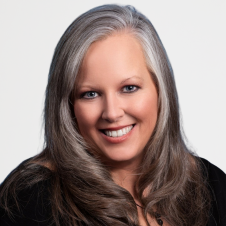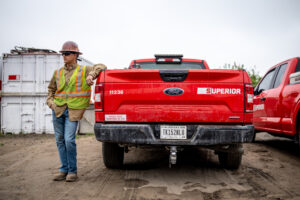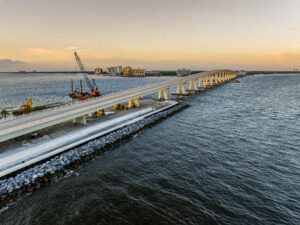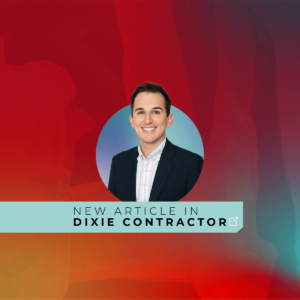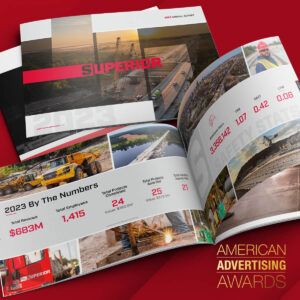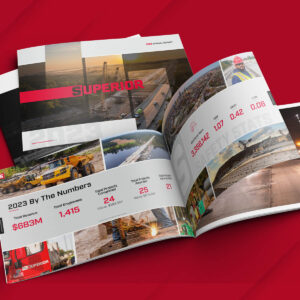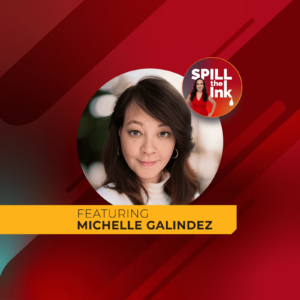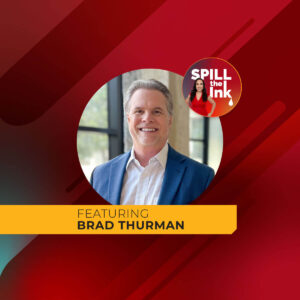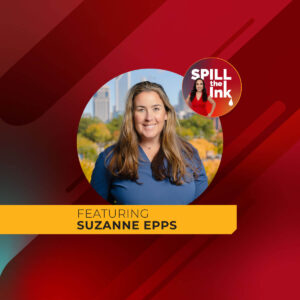
Spill the Ink: The Reputation Ink Podcast
Crafting AEC content that captivates and inspires learning
With endless amounts of stimuli constantly grabbing for our attention, convincing audiences to read complex technical information can be a hard sell. As Kleinschmidt’s marketing and communications director, GinaRenee Autrey pursues opportunities where her engineers can blend creativity and technical expertise. Their goal isn’t to merely distribute information, but rather to inspire audiences to want to learn.
In this episode, GinaRenee discusses how engineering firms can think outside the box to captivate their audiences’ attention, including sharing Kleinschmidt’s recent success with a Shakespeare-inspired article on dam decommissioning. She also reflects on the importance of marketing engineering firms by offering clients easy-to-understand solutions to their complex problems.
Here’s a glimpse of what you’ll learn
- What trends are influencing how engineering firms market their services
- How prioritizing a creative execution has enhanced Kleinschmidt’s approach to thought leadership
- What B2B buyers care about when choosing an engineering partner and how to align your marketing strategy to meet their needs
- How to use webinars to position employees and firms as experts in niche engineering topics
- How Kleinschmidt’s marketing team supports and trains its engineers to become better speakers, even when they’re nervous about appearing in front of crowds
- Why you should incentivize your field teams to take pictures and videos at jobsites
About our featured guest
GinaRenee Autrey is a seasoned marketing maestro with over 24 years of curating and executing comprehensive marketing strategies to elevate business goals. Her approach is results-driven, creative and ever-evolving, aligning with the rapid pace of the A/E/C marketing landscape. GinaRenee has honed a diverse set of skills over the years — from managing successful marketing initiatives and campaigns to public relations and advertising to implementing strategic projects that have fueled growth in targeted markets.
GinaRenee currently serves as program manager for the Kleinschmidt Justice, Equity, Diversity, and Inclusion (JEDI) Council. This role is purpose-driven and close to her heart. GinaRenee is an active member of the Society for Marketing Professional Services (SMPS) and one of the Program Chairs for the 2024 Amplify A|E|C Conference. She is also a member of the Public Relations Society of America (PRSA), and the American Marketing Association (AMA). GinaRenee began her public speaking journey on the stage at the SMPS SERC Conference in 2022. Since then, she’s had the pleasure of engaging audiences at numerous SMPS conferences and webinars, enriching her professional journey even further. GinaRenee hopes to help other marketers through these engagements to realize their full potential and view themselves as “technical experts” in their field.
Resources mentioned in this episode
- Check out Kleinschmidt
- Follow Kleinschmidt on LinkedIn, X and Instagram
- Connect with GinaRenee Autrey on LinkedIn
- Say hello to Michelle Calcote King on X and LinkedIn
- Read Kleinschmidt’s article, “To Be or Not to Be…That is the Dam Question”
Sponsor for this episode
This episode is brought to you by Reputation Ink.
Founded by Michelle Calcote King, Reputation Ink is a public relations and content marketing agency that serves professional services firms of all shapes and sizes across the United States, including corporate law firms and architecture, engineering and construction (AEC) firms.
Reputation Ink understands how sophisticated corporate buyers find and select professional services firms. For more than a decade, they have helped firms grow through thought leadership-fueled strategies, including public relations, content marketing, video marketing, social media, podcasting, marketing strategy services and more.
To learn more, visit www.rep-ink.com or email them at [email protected] today.
Transcript
[00:00:00] GinaRenee: Trying to do things that will grab people’s attention and make them say, “What is this?” and want to learn more and read.
[00:00:10] Announcer: Welcome to “Spill the Ink,” a podcast by Reputation Ink where we feature experts in growth and brand visibility for law firms and architecture, engineering and construction firms. Now, let’s get started with the show.
[00:00:26] Michelle: Hi, everyone. Thanks for listening. I’m Michelle Calcote King. I’m your host, and I’m the principal and president of Reputation Ink. We’re a public relations and content marketing agency for B2B professional services firms, including architecture, engineering and construction firms. To learn more, go to www.rep-ink.com.
Kleinschmidt is an engineering consulting firm that serves the hydroelectric, renewable power and water resources markets. They work with energy companies and government agencies to protect and enhance the natural environment with their solutions.
Today, I’m excited to be joined by their marketing and communications director, GinaRenee Autrey.
[00:01:06] GinaRenee: Thank you so much for having me.
[00:01:08] Michelle: Yes. GinaRenee’s been with Kleinschmidt for the last six years, but her experience spans a 25-year career in AEC marketing. She’s led all kinds of marketing activities. She’s done the strategic planning, to the advertising, to the public relations, to the event planning. She’s also a very active member of organizations like SMPS, the American Marketing Association, and the Public Relations Society of America.
I’m really excited to talk to her because she’s done a lot of presenting for SMPS and a lot of organizations on some really interesting topics. Tell me, how did you end up in AEC marketing?
[00:01:43] GinaRenee: I started out my career completely outside of the industry and worked as an administrative professional for several years and really got interested in the marketing aspects when I started working for a company that did B2C selling a product in the construction industry. I came in through that route. Once I got involved in it, I just loved it. I have a passion for it. I enjoy it. I’ve been here for many years, been doing this for about 24 years. Yes, that’s how I got into it. Though I started as an administrative professional and then moved into the marketing role.
[00:02:27] Michelle: Nice.
Kleinschmidt has 11 offices around North America. Tell me about your marketing team. How big is it?
[00:02:35] GinaRenee: The marketing team — and we do it a little bit different than some of the AEC firms do, we keep our marketing and proposals separate. We have three proposal professionals on our team and then three marketing professionals: myself, then I have two marketing coordinators, Jill and Taylor, who assist with all the tasks for the company.
[00:02:56] Michelle: Okay. That’s a smaller size team for as big of a company as you’ve got.
Tell me about the trends that are impacting your work.
[00:03:06] GinaRenee: I think right now the biggest trend is the hot topic of course is generative AI. Learning what is going to work for us. I view it as not something that’s coming in trying to take our jobs, but more of something that’s coming in to help us do our jobs more efficiently.
We’ve embraced it on our team and are using it. We’ve been using it for about almost a year now. It’s a regular everyday use thing, but it changes constantly. It’s always being updated, upgraded.
I guess just navigating the changing digital landscape. We’re going to a cookie-less world soon where it’s going to really impact marketers, especially if you use tools like HubSpot and things to do e-blast and things of that nature.
LinkedIn is coming out with a lot of new tools and we’re big LinkedIn users. They have this new Accelerate tool that’s coming out that’s AI-based. There’s so many things that are coming out. GA4, the old analytics has gone away.
There’s some learning curve and just trying to stay on board with the new technology that’s coming out. That’s probably our biggest challenge that we’re dealing with right now it’s just trying to stay with the flow.
[00:04:21] Michelle: I know. It’s sometimes a little exhausting.
[00:04:25] GinaRenee: It is.
[00:04:25] Michelle: I don’t know about you, but–
Tell me, what are some of your favorite tools that your team seems to get the most out of in terms of the AI?
[00:04:34] GinaRenee: We love ChatGPT. That was our first one we used. It learns you over time. We have a really good flow going with ChatGPT right now. I’ve tried Jasper and a couple of other tools. I don’t know, we have a spreadsheet where we’ve tracked and tried out a bunch of different tools and tried to analyze which ones work best for us. ChatGPT is primarily–
Of course, Grammarly, Canva, Adobe all have AI embedded now. ChatGPT is probably the main one that we’re using.
[00:05:08] Michelle: You sound like us. It’s interesting. Yes. It’s like when you adopt one, then you see your main tools they seem to gobble up the companies that are launching these tools and then it’s just embedded into your main tool.
[00:05:25] GinaRenee: Which is helpful.
[00:05:26] Michelle: Very much so. Yes. You don’t have to sit there and switch between–
I love Grammarly. I’m a big Grammarly fan. It catches all kinds of things for me. I’m a writer.
[00:05:38] GinaRenee: Same.
[00:05:38] Michelle: It’s fantastic.
How do you see marketing an engineering firm different than marketing, say, in architecture or a construction firm?
[00:05:47] GinaRenee: I’ve worked for large construction firms. In my past I worked with Gilbane. I’ve worked for Wood Group Mustang and a couple of others. I guess to me, when you think of architecture marketing, it’s all about the aesthetics and the look and feel of things. The construction is very focused on project execution, project management.
In our role, it’s more about marketing our technical expertise. We’re really focused on thought leadership, white papers, technical articles, case studies, all those kinds of things. It’s just different in those ways. You’re focused on different outcomes.
Usually, our projects are a very long cycle as well. We can be working on relicensing projects that run for seven years. It’s a little bit different in that aspect. There are similarities with all of them as well.
[00:06:48] Michelle: Sure. Tell me about your thought leadership and getting that technical content done. What are some of the keys for you? How do you get that done? Are your engineers writing content? How are you getting that constant need for that content to be created done and out the door?
[00:07:09] GinaRenee: Right. We tackle that in a few different ways. When we first started, they were really just focused on technical journal articles. We have scientists on staff because we also do environmental work as well. They were very focused on technical journal articles that were going into, like, Fisheries Society of America, things like that.
I really had to switch the narrative here from these technical journal articles to more marketing speak articles so that you could reach a wider audience. It was a challenge at first, and especially the direction that we wanted to go because we do a lot of themed thought leadership.
People are overwhelmed with digital content. Their attention spans are much shorter, especially since the pandemic. I don’t know what happened, but the attention spans are just way shorter. Trying to do things that will grab people’s attention and make them say, “What is this?” and want to learn more and read.
I’ll give a good example. We did a dam decommissioning paper, and we used Shakespeare. It was called, “To Be or Not To Be, That is the Dam Question.” We used imagery from Shakespeare and we had a playwright theme throughout the paper, but it was all about the technical information about how to decommission a dam.
[00:08:38] Michelle: Interesting.
[00:08:39] GinaRenee: Tying together creative with the technical expertise is really the sweet spot. We found it to be enormously successful. Once the technical staff saw that effort — and that effort took about a year and a half to get from start to finish–
[00:08:54] Michelle: I can imagine.
[00:08:58] GinaRenee: Once they saw the success of it, it completely changed the game. Now they’re more willing to participate with us and develop the content.
We don’t use generative AI much on our thought leadership because we want it to be genuine thought leadership. It can be a challenge and time-consuming because you have to make sure you’re working with your staff, especially when they have client-billable things that they have to be focused on. The themed thought leadership was really a game changer for us. Once they saw how it worked– And it brought work in the door. It was not just putting stuff out and never knowing what happens from it.We were able to track it and we tied millions of dollars’ worth of work that came in to the thought leadership paper.
[00:09:46] Michelle: Oh, I love that.
[00:09:46] GinaRenee: Yes, we actually had a client contact us and change the scope of their RFP that they were getting ready to put out based on the information that was in our paper.
[00:09:56] Michelle: Wow, that’s really, really impressive.
[00:10:00] GinaRenee: It was awesome. All of the visuals were Shakespeare leaning over a dam. It was shocking. It was very different. Usually in our industry, publications and newsletters, you see a picture of a dam, and then “This is how great we are at doing dams.” When they saw these weird images– [laughs]
[00:10:19] Michelle: Right, it stood out.
[00:10:20] GinaRenee: –it made them stop. They’re like, “Why is Shakespeare in my newsletter?” They would click, and the engagement rates were off the charts.
[00:10:28] Michelle: Fantastic.
[00:10:29] GinaRenee: We had a 60% engagement rate in industry publications, which I’ve never seen in my career.
[00:10:34] Michelle: Wow, that’s fantastic.
[00:10:35] GinaRenee: It’s wild.
[00:10:36] Michelle: How are you distributing your content? Are you going through trade publications mainly? Are you doing email? What’s your distribution method?
[00:10:44] GinaRenee: Combination all of the above. We do some digital advertising in our industry newsletters. We had some print advertisements that were in with a QR code that they could scan to go to. We promoted them at industry conferences with a QR code that was set up in the booth where they could go and learn more and download the paper.
E-blast. I don’t do a lot of mass-blasting, but that was one I mass-blasted. We took a lot of different tactics to see what was going to resonate the most with our clients and do a little testing about how they like to consume data. We hit it from all angles that were possible. [laughs]
[00:11:25] Michelle: Yes. That’s really smart to look at– Because the industry does have a lot of similar content. When people do see the same kind of images over and over again, you have to stand out. Yes, that’s really fascinating.
I had seen a presentation that you did about how to grab a B2B’s audience and entertain them while piquing their curiosity. Did you use that as a case study?
[00:11:56] GinaRenee: I did.
[00:11:56] Michelle: Yes. I love that. Yes. Fantastic. That’s great.
[00:12:01] GinaRenee: We’re currently developing one with a Dr. Seuss theme. This one’s a little more challenging, so it’s going to be interesting.
[00:12:11] Michelle: Yes. Oh, I love that. That’s fantastic. Okay, let’s your talk about your target audience. What are some of the things that they care about when selecting an engineering partner? What do you think that is on top of their minds?
[00:12:25] GinaRenee: A lot of them have these complex issues that they’re facing in regards to regulatory requirements. There’s a lot of government agencies involved with anything to do with a hydroelectric facility, whether it’s the relicensing, virtually anything. Fish passage is a big topic right now with making sure that fish can get where they need to get to spawn. Finding ways to either go under, around or over the dam is a big topic for us right now.
The main thing that our clients are looking for is solutions to their complex problems that are not complex.We want to come in and help you with your complex problem of giving you a simple solution — not simple, but easy to understand solution and help you meet those challenges and meet all your requirements that are being required by the government agencies. There’s a lot of that type of work. Our regulatory staff is one of our busiest groups in our company. It’s a lot of that kind of thing.
They really want someone to help guide them through the process because it can be very daunting and lots of red tape. We’ve dealt with these agencies and know the process and know how to help them get through them all.
[00:13:43] Michelle: Got it.
[00:13:44] GinaRenee: They really want somebody just to help guide them through the process that they have to go through. We want to position ourselves as the people to come to you that we have that need.
[00:13:51] Michelle: Yes. The experts.
I saw also that you do a lot of speaking and webinars. Those are critical position-as-experts type tactics. Tell me about the webinars and how that’s worked for you and your strategy.
[00:14:10] GinaRenee: We did have several what we would call industry experts, and I’ll use one as an example. His name is Chris Goodell, and he’s very well known in the hydraulics and hydrology world, the HEC-RAS world. Him and his team do a podcast called “Full Momentum.” It’s all tied in with their webinar series where they’re training people on how to use HEC-RAS. We even have our competitors come and take these classes as well as our partners or just people who are in different industries, even, that need to learn how to use it for water modeling, especially when they’re developing emergency action plans for if there’s a damn failure or a levee failure.With climate change, there’s all these wild weather events that are wreaking havoc on a lot of our systems.
He is very well known. We started doing the webinar series. I think the first one, they had 10 people come. It’s like, “Okay, get it going.” Now we’re up to, we do one to two live sessions per year where we are maxed out on how many people we can let attend. Our webinars are averaging 50 to 60 attendees, and we do four of those a year.
They’re very effective in helping to not only establish Chris as that industry go-to expert for H&H but establish Kleinschmidt as the H&H experts as well. It works on both sides, which is really cool.
[00:15:42] Michelle: I saw that you spoke about how at SMPS about how to become better speakers. Tell me some of those tips that you gave. I’m guessing you train your internal folks then before they speak.
[00:15:59] GinaRenee: Yes. We put most of what we call our doer-sellers through presentation training to help them. We used Graceworks in the past and just trying to help them be more comfortable because believe it or not, a lot of engineers don’t like talking in front of people.
[00:16:16] Michelle: Crazy
[laughter]
[00:16:19] GinaRenee: They get very nervous. A lot of them don’t like to what they feel is called chest beating or promoting themselves. You have to address that as well.
We put them through presentation training, and then we also help them with scripts. If they’re doing interviews or things like that, we make sure that they’re well-prepared in advance. When they’re speaking, the marketing team assists with every presentation that goes out the door for a speaking engagement, we’re involved in it so that we can help them make sure they’re putting the best foot forward and making sure that the content that they’re talking about is also presented in a good way.
It’s not just about what you’re saying, it’s about the look and feel of everything as well and being able to maintain people’s attention. Those are just some of the things that we do. We make sure that marketing is involved in every single presentation that’s available where people are speaking, especially at the industry conferences.
[00:17:19] Michelle: I can imagine. Do you get involved in the follow-up afterwards? Because I often find that’s where speaking falls through. That making sure that there’s the follow-up with any interest afterward or leave-behinds or ways for people to get in touch, that kind of thing.
[00:17:39] GinaRenee: With Chris, we have a whole website section devoted to the H&H stuff that he’s doing. He has a blog. It’s his own thing at this point. It’s a whole thing. Everyone else, we do a debrief, usually one to two weeks after their speaking engagement, just to see what went well, what didn’t work, what they felt they struggled with, those kind of things. We do often leave our presentations behind. We will develop landing pages for conferences where we have people speaking, and we can direct them there from social media and other industry.
We’ll even put a link sometimes as an ad in an industry newsletter, say, “Hey, in case you miss out, here’s the presentation.” Trying different type. It seems like it’s different with every little niche in our industry because you have fisheries, you have regulatory, hydro-engineering. They all are a little bit different, so we try to tailor it to those different niches.
[00:18:44] Michelle: That’s great.
The next thing I want to ask you about is JEDI. Which is so great. You guys have this Justice, Equity, Diversity, and Inclusion Council, which they’ve got the acronym the JEDI Council. Tell me about it. Why did the firm create it? What are its goals? Who came up with that fantastic name?
[00:19:11] GinaRenee: [laughs] I can’t remember who came up with the exact name, but it started very casually. Our CEO had a great interest in the firm being more diverse. Hydropower is pretty much an old white-man industry. There’s also a lot of the Women in Hydropower that’s working to overcome that. We started to engage with a lot of industry associations that are trying to change that. We knew that in order to do that, we had to change our selves as well.
There’s conscious efforts for us to be more inclusive and more diverse. It started with our CEO. It really actually started after the George Floyd situation.We were having some conversations and narrative and our CEO was like, “We need to have a group that tackles some of these things. We need to do better.” He started it up. Then we formed the council. I can’t remember who came up with the name, but we have a lot of Star Wars fans. I’m sure it was somebody who is a big Star Wars fan.
We really just started trying to implement and make small changes at our firm. Then it turned into this industry engagement because it’s not just a Kleinschmidt problem. It’s a engineering problem in general, pretty much. There’s all initiatives to try to get more women into STEM and into engineering.
We started with looking internally and what could we do and changing the narrative around some of the things that we work on, engaging more with indigenous communities because we engage with them a lot with the fisheries; more with Women in Renewable Energy; Women in Hydropower; and just connecting and taking some of what they’ve learned and applying it to our firm and then sharing back what we learned as part of that.
It really was like a from the heart thing with our CEO that started it.He had this moment of, “We need to do better.” We already had things in place to be diverse, but it wasn’t formalized. This was a “We need to make this a thing and do more and do better.” It was really his passion that started it.
[00:21:45] Michelle: Cool. I love it. That’s fantastic.
Tell me about public relations. Does the firm do a lot of article placement? I’m guessing if thought leadership’s important? Are you placing a lot of articles still in the trade publications? Is that a part of your strategy?
[00:22:04] GinaRenee: Yes. Probably more limited now than it was because we’ve tried to mix it up and have the marketing-ease thought leadership, the themed content. Then they still are doing their journal articles. But it takes a while to develop that content.
I would probably say we have about four to six per year of the journal articles. We try to have at least one big themed thought leadership that we do per year because they take a while, and it takes a while to get the word out and do the entire campaign. We were doing this campaign for like six, eight months and still get leads off of it now. It’s been like a year ago.
We don’t try to overextend ourselves and we don’t want our technical staff to become frustrated. “These marketing people need me again. I’ve gotta be billable.”
[00:23:03] Michelle: Right. I’ve been there.
[00:23:06] GinaRenee: Really trying to make it a good balance where they don’t feel overwhelmed, and we can still accomplish the goals that we set.
[00:23:14] Michelle: Yes, it’s interesting. I hire a lot of former journalists and they’re always so shocked at how long the content takes on the B2B side. They’re so used to that daily churn of getting out four or five stories a day. Then welcome to the world of complex B2B content creation where you might work on one piece, like you said, for eight months. There’s just so many people involved in approvals and people are so busy. Yes, but you’re right. One piece can generate and can be broken up into smaller pieces and used in different ways. Yes, it’s a totally different type of content.
Your Knowledge Hub and your STEM Center, tell me about the differences in the two. I’d love to hear about the STEM Center. I’m guessing your Knowledge Hub is just your area where you’re collecting everything that the firm does.
[00:24:12] GinaRenee: Yes.
[00:24:12] Michelle: What is the STEM Center?
[00:24:14] GinaRenee: We do have the Knowledge Hub and the STEM Center on the website. We do a lot of work in the community around STEM. We have a lot of our people that go into high schools, junior high schools. We have several people that they’re very passionate about that, about helping develop the next generation of people coming into the hydropower sector. We love them. We want to support them and give them some resources that they can share with the students to learn more after they’ve been there. That was the primary driver behind the STEM Center was just making sure that there was basic, “Here’s what it is,” and where they can learn more about it at a very basic level.Just something that they could share with students after those engagements.
The Knowledge Hub really houses like all of our thought leadership, press releases, everything for the H&H stuff with Chris is centered there as well. It takes you to where it needs to go. It’s really just all of the knowledge that we have when we’re sharing it out. We keep it in one place. So it’s easy for people to find on our website.
[00:25:24] Interviewer: The one thing I didn’t think about asking was video. Tell me about how you’re using video.
[00:25:30] GinaRenee: We don’t typically, and even with our photos, we don’t hire out videographers or photographers. We do a photo challenge contest with our field staff every year.
[00:25:45] Michelle: Oh, cool. Interesting.
[00:25:46] GinaRenee: They take pictures, and iPhones take remarkable photos.
[00:25:51] Michelle: I know. It’s wild, isn’t it?
[00:25:53] GinaRenee: Yes, it is. A
ll the images that on our website and even our booth graphics, everything were images that were taken by our employees.
[00:26:03] Michelle: Oh, wow.
[00:26:04] GinaRenee: We don’t do paid photography or anything like that. I’d rather use that money in other ways than paying.
We have the photo challenge, and we are getting ready to implement video into that next year where we’re going to encourage people to take video of that. Right now, it’s pretty much our staff providing video content. Both of the coordinators are extremely talented with Premiere. They’re able to edit and make it look nice. We’re doing more video around our account-based marketing initiatives with messages from our PMs and messages where there’s leadership changes with the account and those types of things. We’re trying to implement more and more video and into our social media as well.
[00:26:51] Michelle: Okay. Like a talking head type video where you’re introducing a new PM or something like that? Oh, interesting.
[00:27:01] GinaRenee: Yes. Even in strategic pursuits, we just recently had some staff go out to a jobsite where the RFP is going to be taking place, where the work is going to be taking and film them talking about the project and their passion for the project and the river system and turn that into a marketing-esque piece of the content that went into the shortlist interview. That was very effective.
[00:27:27] Michelle: Very cool.
[00:27:28] GinaRenee: Yes. We’re trying to do some different things and just see what resonates because video is the number one content.
[00:27:36] Interviewer: I know.
[00:27:36] GinaRenee: It’s just hard.
[00:27:36] Michelle: LinkedIn came out with reels.
[00:27:40] GinaRenee: It’s hard to make the time to get that.
[00:27:44] Michelle: It really is. Yes.
[00:27:46] GinaRenee: We’re trying to do more of that as we move into the coming year. That’s a big target for next year.
[00:27:50] Michelle: Yes. You have to train yourself to, because we’re so used to — people our age — the written word, I think. I’m used to sitting down and writing an email or a blog, and training yourself to think, “I’ll create a short video,” is a different mindset and a different shift. It can be just as quick and short, but you have to switch, and you have to reskill yourself for that medium, I think. It’s a reskilling and a rethink.
[00:28:26] GinaRenee: Absolutely.
[00:28:27] Michelle: You’re right. It is the number one medium. You’re really smart to empower your people to capture a lot of that. They’re the ones on-site. They’re ones with the things that are impactful visually. That’s really fascinating.
[00:28:51] GinaRenee: The better challenge is it runs from what we call field season. Basically, from April to October. They’re out in some of the most beautiful locations and especially some of the photos we’ve gotten from Alaska were just mind-blowing beautiful. A lot of these river systems just have beautiful scenery. They will do some stage pictures. We have it, Field Photos, People in the Field so that we capture our staff in the field, and then what we call our Community Engagement. If they get to go out to a dinner with the client or they go out as a team, we want to make sure that we’re capturing photos of all of those things.
Then we give prizes for the best photos. We vote on them. We have a team that votes on them each month and they get pretty cool prizes for winning. We do first, second, third, and honorable mention each month.
[00:29:49] Michelle: That’s great.
[00:29:49] GinaRenee: It’s a big competition. They love to be in the photo challenge because we feature them on our internal news space, we feature them on social media. They get put on the website and use their marketing materials.
[00:30:01] Michelle: People love that.
[00:30:02] GinaRenee: Yes, they love it. That’s been a really fun thing, and we average– Oh my gosh, there’s been some months where we get 80 photos in a month, which is phenomenal. The more the merrier. [laughs]
[00:30:18] Michelle: That’s great. I love that a lot. You’re right, the technology is– I was once, this was actually two or three years ago, interviewed for broadcast TV. I was doing something for a nonprofit and the reporter showed up with an iPhone and did the interview for broadcast TV via an iPhone. I was like, “Oh, okay.” He had an external mic at the time. There was a few extra setups, but it was through an iPhone, and it went on broadcast.
[00:30:45] GinaRenee: It’s a different world. [laughs]
[00:30:48] Michelle: It really is. I feel a little bit sorry for the professional videographers out there.
[00:30:54] GinaRenee: I know.
[00:30:55] Michelle: There’s still a place for them but for that kind of thing, and especially because there are spaces where having a professional videographer is not going to happen on those projects.
That’s fantastic.
[00:31:13] GinaRenee: Sometimes it’s challenging to get permission from the client to have the professional videographers come.
[00:31:18] Michelle: Right.
[00:31:19] GinaRenee: A lot of the large utilities now are really security-conscious. There’s that issue and having to overcome all that. It’s just a bunch of red tape and it’s just easier for our– Because they don’t mind if our staff do it because they’re already there. It’s kind of a workaround.
[00:31:36] Michelle: And just getting your people, like you were talking about the social events and things like that. And content without images is just useless on social media.
[00:31:45] GinaRenee: Exactly. For sure.
[00:31:48] Michelle: You’ve just got to have that imagery.
Anyways, thank you. I always like to ask at the end of the interview if there’s one final thought you’d like to leave our listeners with in terms of best practices for marketing an engineering firm, what you’ve learned over your long career in AEC.
[00:32:12] GinaRenee: I think the biggest takeaway I can give anyone is, view yourself as a technical expert, just like the staff that you’re working with. You are just as much a technical expert as an engineer or project manager in your field. View yourself in that way and make sure that you’re working to get your seat at the table and be heard. Business development efforts have changed so much over the years, and we learned a lot during the pandemic. They really turned to marketing during the pandemic of, “We need your help. We can’t go and meet with our clients.” We had to come up with ways to make that happen.
Having that seat at the table and letting your voice be heard. Work with your direct manager to make sure that he’s advocating for you to have that seat. I’m very fortunate that I have that here. Marketing is very valued here. They see the value that we bring to the firm. If you have to build your case, build your case. Keep all of your analytics and data and make sure you’re sharing it up, even if they don’t ask for it. “This is what social media did this month. This is the feedback we got from this campaign.” Because the more you’re communicating that up, the more they’re going to realize the value that you’re bringing and help get that seat at the table. View yourself as a technical expert because you are.
[00:33:36] Michelle: I love that.
[00:33:37] GinaRenee: You had to have training to do what you do just like they did. Definitely, one thing that I’m very passionate about with AEC marketers is making sure that we’re elevated and have that recognition and that seat at the table.
[00:33:51] Michelle: I love that. Take it from someone who is on the board of directors at her firm. I love that. Thank you very much. We’ve been talking to GinaRenee Autrey of Kleinschmidt. If anyone wanted to get in touch with you and talk more, what’s the best way for them to do that?
[00:34:08] GinaRenee: You can link me up on LinkedIn. It’s /GinaRenee Autrey, and happy to connect there. You can contact me through the Kleinschmidt website. I get all the emails. We have like the longest email address ever, so I won’t even try to put that out. LinkedIn is the best way to get in touch.
[00:34:28] Michelle: Awesome.
[00:34:29] GinaRenee: I love to have discussions and help people. I think mentoring is very important. In every way that we can, we’ve got to help people to elevate. If anybody wants to reach out, happy to talk.
[00:34:41] Michelle: Great. Thanks so much.
[00:34:43] GinaRenee: You’re welcome.
[music]
[00:34:44] Announcer: Thanks for listening to “Spill the Ink,” a podcast by Reputation Ink. We’ll see you again next time. Be sure to click “Subscribe” to get future episodes.
[music]
Related AEC
Maximizing Employee Engagement Through a Compelling Employee Newsletter
Reputation Ink | Jun. 24, 2025
Rebuilding a Construction Company’s Brand with Impactful Visuals
Reputation Ink | Jun. 24, 2025
How AEC Firms Can Communicate Urgently Yet Empathetically in the Wake of a Natural Disaster
Reputation Ink | Jun. 24, 2025
Join the INKsights Email List
Get Exclusive Updates on Awards, Lists, Rankings, Editorial Opps and More.
Subscribe to our newsletter, INKsights, to receive insights (pun intended) on thought leadership, public relations, and marketing for B2B professional services firms sent straight to your inbox.
Available only to our email subscribers:
Once a month, you’ll receive the latest awards, rankings, lists and editorial opportunities in the legal or AEC industry (you choose which you’d like to receive).
In the off weeks, we send you our latest thinking on the marketing and PR issues facing those industries. You can opt out anytime (although we’ll bet our favorite coffee mug you’ll never want to leave).
